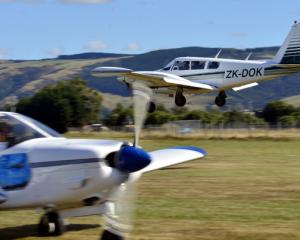The International Air Transport Association yesterday slashed its 2011 airline industry profit to $US4 billion ($NZ4.92 billion), a 54% fall compared with the $US8.6 billion forecast in March.
The 2011 forecast was a 78% drop compared with the $US18 billion net profit recorded last year.
On expected revenue of $US598 billion, a $US4 billion profit equates to a 0.7% margin.
"Natural disasters in Japan, unrest in the Middle East and North Africa, plus the sharp rise in oil prices have slashed industry profit expectations this year," association director general Giovanni Bisignani said in a statement.
"That we are making any money at all in a year with the combination of unprecedented shocks is a result of a very fragile balance."
The efficiency gains of the last decade and the strengthening global economic environment were balancing the high prices of fuel.
But with a "dismal" 0.7% margin, there was little buffer left against further shocks, Mr Bisignani said.
The cost of fuel was the main cause of profitability.
The average oil price for 2011 was now expected to be $US100 a barrel, a 15% increase over the previous forecast of $US96 per barrel.
For each dollar increase in the average annual oil price, airlines faced an additional $US1.6 billion in costs.
With estimates 50% of the industry's fuel requirement was hedged at 2010 prices, the industry's 2011 bill would rise by $US10 billion to $US176 billion, Mr Bisignani said.
Fuel was now estimated to comprise 30% of airline costs - more than double the 13% of 2011.
"We have built enormous efficiencies over the last decade. In 2001, we needed oil below $US25 per barrel to be profitable.
"Today, we are looking at a small profit with oil at $US110 per barrel," he said.
The current fuel price spike was substantially different from the one that occurred in 2008, he said.
First, while oil inventories were low, there was substantial spare Opec and refinery capacity, which was not the case three years ago.
Second, the monetary expansion that fuelled a surge in financial investments in commodities was ending, which would remove a major upward pressure on fuel prices.
Nonetheless, volatility in the fuel prices remained one of the industry's major challenges.
Despite high energy costs, world trade and corporate earnings continue to improve.
As a result, global GDP projections increased 0.1% to 3.2%, which was supporting continued demand for air transport, Mr Bisignani said.
Growth rates for both cargo and passenger markets had been revised down because of higher fuel prices.
The number of price-sensitive leisure travellers had fallen by 3% to 4% in the past five months as travel costs were forced higher by fuel prices.
The association forecast that Asia-Pacific carriers were expected to earn $US2.1 billion this year, the most profitable of all regions.
"Even so, this is dramatically down from the $US10 billion profit the region achieved in 2010.
"Airlines in this region are more exposed than others to cargo markets and fuel price fluctuations," Mr Bisignani said.
Asia-Pacific airlines carried 40% of all air freight volumes, while low labour costs and relatively low hedging meant fuel accounts for a bigger proportion of total costs.
In addition, the Japanese earthquake and tsunami were expected to dent the region's prospects for the remainder of the year.
That would be more than offset by robust growth in both China and India.
The continued dynamism of those economies meant Asia-Pacific was the only region demand increases (6.4%) were expected to outpace capacity growth (5.9%), Mr Bisignani said.



